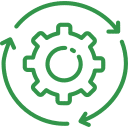Microsoft Dynamics 365 Business Central
Cloud ERP for Small and Mid-Sized Businesses

What is Business Central?
ERP Modules of Microsoft Dynamics 365 Business Central

General Ledger
Track all financial transactions with a comprehensive chart of accounts and generate compliant financial reports.

Cash Flow Management
Forecast and optimize cash positions for informed financial decision-making.

Accounts Payable:
Manage vendor profiles, process invoices, and streamline payments to maintain strong vendor relationships

Fixed Assets Management
Track asset acquisition, depreciation, and disposal to ensure accurate financial reporting.

Accounts Receivable
Handle customer data, billing, and collections while providing efficient account reconciliation.

Expense Management
Capture and approve employee expenses to streamline reimbursements and credit card reconciliations.

Budgeting & Forecasting

Tax Management
Calculate VAT/GST, prepare tax reports, and ensure compliance with global tax regulations.

Sales Orders
Streamline order processing to fulfill customer orders quickly and accurately.

Pricing and Discounts
Define flexible pricing structures and discounts to incentivize sales and drive revenue growth.

Marketing Campaigns
Execute and monitor targeted marketing campaigns while analyzing ROI and customer segmentation

Sales Forecasting
Predict future sales trends based on historical data, pipeline analysis, and current market conditions.

Customer Relationship Management (CRM):
Manage customer profiles, leads, and opportunities to tailor customer interactions.

Sales Returns
Handle product returns and refunds efficiently while maintaining positive customer relationships

Opportunity Management
Track and manage the entire sales pipeline from lead generation to deal closure.

Quote Management
Create, modify, and track quotes for potential customers to streamline conversion.

Vendor Management
Monitor vendor performance, manage contracts, and streamline procurement for reliable sourcing.

Demand Forecasting
Analyze historical data to forecast demand and align procurement with production needs.

Procurement
Automate purchasing workflows to ensure timely procurement of materials and goods.

Supplier Collaboration
Foster collaborative relationships with suppliers for efficient communication and inventory management.

Logistics
Optimize transportation planning and route management to reduce shipping costs and delivery times.

Inbound and Outbound Shipments
Coordinate and track inbound and outbound logistics to ensure on-time deliveries.

Purchase Orders
Create and track purchase orders efficiently to maintain a smooth supply chain.

Quality Assurance:
Maintain rigorous quality checks throughout the supply chain to meet customer expectations

Resource Management
Allocate and schedule resources efficiently based on skillsets, availability, and project needs.

Project Billing
Automate project billing to generate invoices based on milestones or time and materials.

Project Costing
Monitor and control project costs in real time to align with budgetary constraints.

Progress Tracking
Track project progress against timelines and budgets for accurate reporting and forecasting.

Timesheets
Record and approve time entries to track billable hours and manage project timelines.

Risk Management:
Identify potential project risks early and develop strategies to mitigate them.

Task Planning and Scheduling
Plan, schedule, and assign tasks to ensure timely project completion.

Change Management:
Manage project scope changes to minimize disruptions and control project timelines.

Stock Levels
Monitor stock levels in real-time to avoid overstocking or stockouts.

Location Management
Organize inventory across multiple locations or warehouses for efficient storage and retrieval.

Replenishment
Automate inventory replenishment based on demand forecasts and reorder points.

Cycle Counting
Perform regular cycle counts to maintain accurate inventory data and minimize discrepancies.

Valuation Methods
Apply valuation methods like FIFO, LIFO, or standard costing for accurate inventory valuation.

Inventory Transfers
Manage transfers between locations to balance inventory levels effectively.

Item Tracking
Track inventory items using serial numbers or lot numbers for traceability.

Kitting & Assembly:
Assemble kits or bundles of products to streamline sales and manufacturing processes.

Picking & Packing
Optimize picking and packing workflows for faster and more accurate order fulfillment.

Cross-Docking
Enable cross-docking to bypass storage and accelerate the distribution of goods.

Storage Management
Allocate and organize storage space based on item turnover and product types.

Zone and Bin Management
Organize warehouses into zones and bins to facilitate efficient inventory handling.

Shipping & Receiving
Streamline inbound receiving and outbound shipping to minimize delays and errors.

Barcode & RFID Scanning
Use barcode or RFID scanning for accurate inventory tracking and data collection.

Warehouse Layout
Design warehouse layouts to reduce travel time and improve picking efficiency.

Labor Management
Track labor productivity and optimize workforce scheduling to maximize efficiency.

Production Planning
Plan production schedules based on demand forecasts and inventory levels to ensure efficient manufacturing.

Work Orders:
Generate and track work orders to ensure that production processes stay on schedule.

Bills of Materials (BOMs):
Create and manage multi-level BOMs for accurate costing and material requirements planning

Shop Floor Management:
Capture real-time data from the shop floor to monitor production progress and make adjustments as needed.

Routing
Define production routing to optimize the workflow and resource utilization.

Quality Management
Implement quality checks at every production stage to ensure product consistency and compliance.

Capacity Planning
Monitor and plan capacity requirements to meet production targets while minimizing bottlenecks.

Production Costing
Calculate production costs accurately to analyze profitability and refine pricing strategies.

Service Contracts
Create and manage service contracts to ensure consistent service delivery and revenue generation.

Resource Scheduling
Schedule technicians and resources effectively for optimal field service operations.

Service Orders
Schedule and assign resources for service tasks efficiently to meet customer requirements.

Service Agreements
Maintain detailed service agreements, including SLA terms, to ensure compliance.

Service Billing
Automate service billing to streamline invoicing based on time, materials, or fixed fees

Knowledge Base
Build and maintain a knowledge base for technicians to provide faster and accurate resolutions.

Service Requests
Handle service requests promptly to resolve customer issues and maintain satisfaction.

Customer Feedback
Collect and analyze customer feedback to refine services and improve client satisfaction.
Business Central Capabilities

Unified Platform
Sales and Service Automation

360-Degree Customer View

Business Intelligence and Insights
Industries we serve

Manufacturing
Gain full control over production, material planning, and job costing.
Retail & eCommerce
Manage multi-location inventory, pricing, and integrate with platforms like Shopify.

Wholesale & Distribution
Improve warehouse efficiency, automate replenishment, and track logistics.

Professional Services
Construction

Healthcare

Education, Non-Profits, Agriculture, and more
Integration & Customization

Connect Easily

Custom Tables & Extensions

API Ready
Key Benefits
01
Unified Business Data
02
Lower IT Overhead
03
All-in-One ERP + CRM
04
Smarter Supply Chain
05
Customizable & Scalable
Ready to Transform Your Business with Dynamics 365?
TESTIMONIAL
What they say about us


